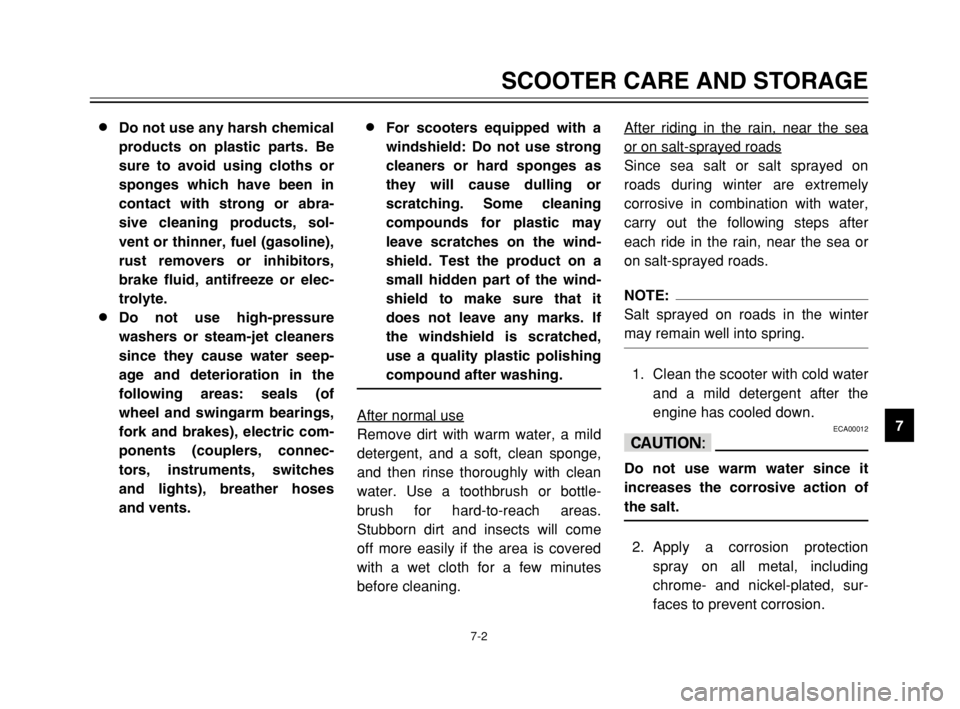Page 36 of 104

4-1
EAU01114
PRE-OPERATION CHECKS
4The condition of a vehicle is the owner’s responsibility. Vital components can start to deteriorate quickly and unexpect-
edly, even if the vehicle remains unused (for example, as a result of exposure to the elements). Any damage, fluid leak-
age or loss of tire air pressure could have serious consequences. Therefore, it is very important, in addition to a thor-
ough visual inspection, to check the following points before each ride.
EAU03439
Pre-operation check list
Pre-operation check list
ITEM CHECKS PAGE
Fuel•Check fuel level in fuel tank.
•Refuel if necessary.
•Check fuel line for leakage.3-4,3-9–3-11
Engine oil•Check oil level in engine.
•If necessary, add recommended oil to specified level.
•Check vehicle for oil leakage.6-12–6-15
Coolant•Check coolant level in reservoir.
•If necessary, add recommended coolant to specified level.
•Check cooling system for leakage.6-17–6-18
Front brake•Check operation.
•If soft or spongy, have Yamaha dealer bleed hydraulic system.
•Check fluid level in reservoir.
•If necessary, add recommended brake fluid to specified level.
•Check hydraulic system for leakage.3-9, 6-25–6-28
Rear brake•Check operation.
•If soft or spongy, have Yamaha dealer bleed hydraulic system.
•Check fluid level in reservoir.
•If necessary, add recommended brake fluid to specified level.
•Check hydraulic system for leakage.3-9, 6-25–6-28
5GJ-28199-E2 9/9/02 9:15 AM Page 34
Page 42 of 104

5-3
OPERATION AND IMPORTANT RIDING POINTS
5
EAU00435
BrakingBraking
1. Close the throttle completely.
2. Apply both front and rear brakes
simultaneously while gradually
increasing the pressure.
EW000057
w
8 8
Avoid braking hard or sudden-
ly (especially when leaning
over to one side), otherwise
the scooter may skid or over-
turn.
8 8
Railroad crossings, streetcar
rails, iron plates on road con-
struction sites, and manhole
covers become extremely slip-
pery when wet. Therefore,
slow down when approaching
such areas and cross them
with caution.
8 8
Keep in mind that braking on a
wet road is much more diffi-
cult.
8 8
Ride slowly down a hill, as
braking downhill can be very
difficult.
EAU04755
Tips for reducing fuel
consumption
Fuel consumption, tips for reducing
Fuel consumption depends largely on
your riding style. Consider the follow-
ing tips to reduce fuel consumption:
8Avoid high engine speeds during
acceleration.
8Avoid high engine speeds with
no load on the engine.
8Turn the engine off instead of let-
ting it idle for an extended length
of time (e.g., in traffic jams, at
traffic lights or at railroad cross-
ings).
5GJ-28199-E2 9/9/02 9:15 AM Page 40
Page 87 of 104

7-2
SCOOTER CARE AND STORAGE
7 8 8
Do not use any harsh chemical
products on plastic parts. Be
sure to avoid using cloths or
sponges which have been in
contact with strong or abra-
sive cleaning products, sol-
vent or thinner, fuel (gasoline),
rust removers or inhibitors,
brake fluid, antifreeze or elec-
trolyte.
8 8
Do not use high-pressure
washers or steam-jet cleaners
since they cause water seep-
age and deterioration in the
following areas: seals (of
wheel and swingarm bearings,
fork and brakes), electric com-
ponents (couplers, connec-
tors, instruments, switches
and lights), breather hoses
and vents.8 8
For scooters equipped with a
windshield: Do not use strong
cleaners or hard sponges as
they will cause dulling or
scratching. Some cleaning
compounds for plastic may
leave scratches on the wind-
shield. Test the product on a
small hidden part of the wind-
shield to make sure that it
does not leave any marks. If
the windshield is scratched,
use a quality plastic polishing
compound after washing.After normal use
Remove dirt with warm water, a mild
detergent, and a soft, clean sponge,
and then rinse thoroughly with clean
water. Use a toothbrush or bottle-
brush for hard-to-reach areas.
Stubborn dirt and insects will come
off more easily if the area is covered
with a wet cloth for a few minutes
before cleaning.After riding in the rain, near the sea
or on salt-sprayed roads
Since sea salt or salt sprayed on
roads during winter are extremely
corrosive in combination with water,
carry out the following steps after
each ride in the rain, near the sea or
on salt-sprayed roads.
NOTE:
Salt sprayed on roads in the winter
may remain well into spring.
1. Clean the scooter with cold water
and a mild detergent after the
engine has cooled down.
ECA00012
cC
Do not use warm water since it
increases the corrosive action of
the salt.
2. Apply a corrosion protection
spray on all metal, including
chrome- and nickel-plated, sur-
faces to prevent corrosion.
5GJ-28199-E2 9/9/02 9:15 AM Page 85
Page 93 of 104

8-2
SPECIFICATIONS
8
Radiator capacity
(including all routes)1.5 L
Air filterDry element
Fuel
Type REGULAR UNLEADED
GASOLINE ONLY
Fuel tank capacity 14 L
Carburetor
Manufacturer MIKUNI
Model × quantity BS30 × 2
Spark plug
Manufacturer/model × quantity NGK/CR7E × 2
Spark plug gap 0.7–0.8 mm
Clutch typeWet, multiple-disc automatic
Transmission
Primary reduction system Helical gear/spur gear
Primary reduction ratio 52/32 ×36/22 (2.659)
Secondary reduction system Chain drive
Secondary reduction ratio 41/25 ×40/29 (2.262)
Transmission type V-belt automatic
Operation Centrifugal automatic typeChassis
Frame type Diamond
Caster angle 28°
Trail 95 mm
Tires
Front
Type Tubeless
Size 120/70-14M/C 55S
Manufacturer/ DUNLOP/D305FA
model BRIDGESTONE/HOOP B03
Rear
Type Tubeless
Size 150/70-14M/C 66S
Manufacturer/ DUNLOP/D305
model BRIDGESTONE/HOOP B02
Maximum load* 183 kg
Air pressure (cold tire)
up to 90 kg load*
Front200 kPa (2.00 kgf/cm
2, 2.00 bar)
Rear 225 kPa (2.25 kgf/cm
2, 2.25 bar)
90 kg load–maximum
load*
Front225 kPa (2.25 kgf/cm
2, 2.25 bar)
Rear 250 kPa (2.50 kgf/cm
2, 2.50 bar)
* Total weight of rider, passenger, cargo and accessories
5GJ-28199-E2 9/9/02 9:15 AM Page 91